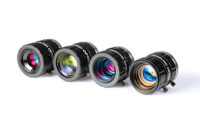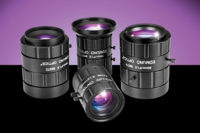Although diffuse axial illumination and inline illumination share some features, inline illumination geometry is defined by some specific characteristics. Inline illumination—also called coaxial illumination—is most often defined by light being introduced into the optical path (typically at the system stop). This is usually accomplished through a port on the side of the lens assembly through which an LED or fiber optic light guide is coupled to a beamsplitter.
Inline illumination is distinct from diffuse axial illumination, where the light source or sources go between the lens assembly and the object under test. The different illumination styles give quite different illumination profiles. This is due to the fact that inline illumination is directional, with the chief ray typically traveling parallel to the optical axis (a reason why inline usage is often coupled with telecentric lenses). Diffuse axial illumination, as its name implies, provides a diffuse and flat field of illumination.
|
TECH TIPS |
|
All this leads to the fact that it is critical to consider characteristics of the object you’re imaging and the information you need to extract from the image. Inline is a good option when your object is specular in nature—that is, when features on the object are generally highly reflective. Taking an example from the world of electronics inspection (where many of the components tend to be reflective), a CCD is perfect to illustrate the difference between inline illumination and another common geometry, that of bright field illumination (such as a standard ring light). Your choice of an optimum illumination geometry depends upon what information you’re trying to extract. If you’re trying to see support electronics in the lower half of the image, the bright field would suit your application best. But if you want to see the wires that are all along the perimeter, then inline is the clear choice to provide high contrast in that region. Either illumination choice could be suitable for imaging the chip on the CCD faceplate, but due to the consistency of the contrast with inline illumination, that is the more reliable option to give you repeatable results.
How Inline Illumination Works
Figure 2 illustrates the illumination pattern of different lighting approaches. The most critical difference is that diffuse illumination sends light to the object from a range of angles, while inline illumination sends light to the object at essentially just one angle. Consider the wires along the edge of the CCD pictured in Figure 1. If you imagine the wires as small cylindrical tubes, you can see why they show up as nice dark lines in our image. If you imagine the wires as small cylindrical tubes, Figure 2 makes it very apparent why they would appear as dark lines under inline illumination. The inline illumination reflects off the specular wires and out of the field. Because the surface behind them is fairly specular and consistent, it reflects the illumination right back into the field. So you see dark wires against a bright background.
Now you might wonder why the level of intensity along the wires varies under the bright field ring light. This is due to the fact that the angle of both the light coming from the bright field source and the wires themselves is different at different points along the length. This is highlighted even further due to the large angular difference of the solder points at the ends of the wires, hence the change from very dark to very bright.
One last example to help further your intuition on how inline illumination will perform is to look at an idealized test target. In this case our target is a straightforward plate of glass, with chrome overlaid on it in the form of a USAF 1951 pattern. Figure 3 shows an image of that target imaged using a bright field ring light on the left and the same target under inline illumination on the right.
As you can see, the resultant images are strikingly different. But with the understanding of how inline illumination works, this should not be surprising. Chrome, being very specular, is directly reflecting the light back up to the lens, whereas the glass is reflecting only a small percentage of the light. The result is a high contrast image of the test target pattern.
These examples illustrate how important it is to consider the features of your object, the characteristics of inline illumination, and the type of information you’re hoping to extract from your images. The interplay among these factors will drive your illumination choice. With an understanding of inline illumination you can better evaluate when it is a viable option to help your imaging tasks succeed.
|
When Inline Illumination is Inappropriate |
|
Although the compact configuration and narrow angle illumination of the inline geometry often make it an excellent choice for high-quality imaging, there are certain conditions that drive you to select another illumination scheme. The decision should not come down to space constraints; it should come from the specifications of your overall system. For example, anytime you’ve got a large field of view (typically anything larger than about four inches) the light from inline illumination spreads out so much that very little of it makes it to any one point on the object. Also, the larger the field, the less forgiving the system is to any imperfections in your illumination source. Smaller fields tend to blend and mask the intensity variations, whereas expanding the source only magnifies any issues. Luckily, most optics designed to function at larger fields do not even offer an inline port as an option. The biggest warning against inline illumination comes in the form of having a highly diffuse object that you must image. As we saw in figure 2, inline illumination draws its advantage from the fact that the light it is projecting can hit the object and reflect back into the lens. This trait is mostly nullified by the Lambertian properties of a highly diffuse object; this means that the light hitting the object is scattered and spread evenly over every angle. This also tends to result in a hot spot on the object from using inline illumination which will greatly lower the overall contrast of any images taken. |





